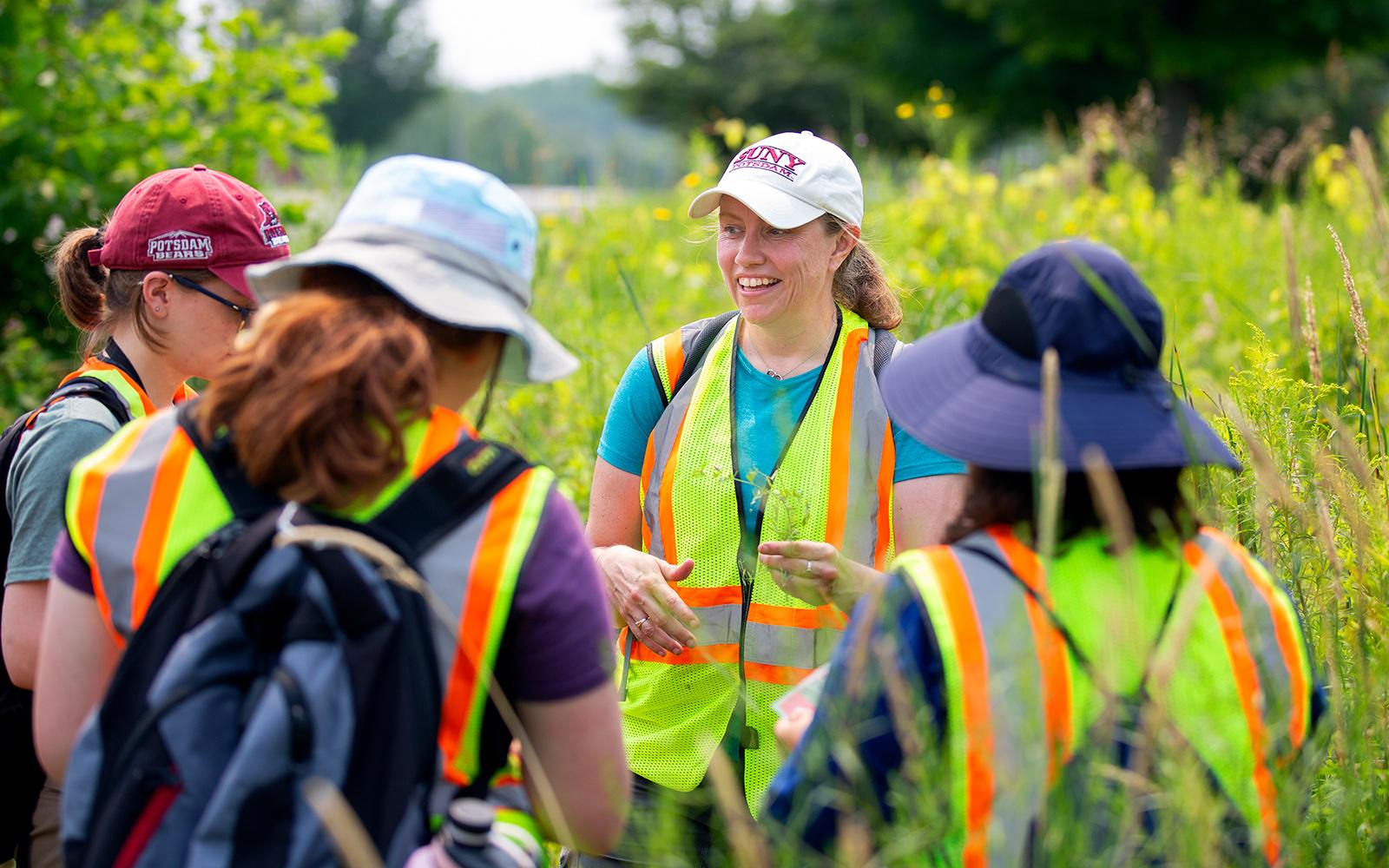Standing outside SUNY Potsdam’s WISER Greenhouse, Grace Romer ’24 uses an aspirator to inhale a beetle into a small glass vile. The tiny beetle, about half the size of a fingernail, is one of thousands of little warriors leading the fight against the purple loosestrife, an invasive species in Northern New York’s wetlands.
What started in 2017 as a GIS mapping project for Dr. Jessica Pearson and her environmental studies students to locate purple loosestrife throughout the North Country, has expanded to include a solution for eliminating the invasive plants by inserting beetles into the equation.

In the beginning, the purple loosestrife was largely understudied in Northern New York. The Department of Environmental Conservation (DEC) had only noted five infestations in St. Lawrence County in 2017, but by the end of the summer, Pearson and her and her research assistants had pinpointed 663 individual points where the purple loosestrife was located along state highways. “I grew up in Potsdam, and when I first came back and started teaching in the North Country, one of things that I noticed was that the wetlands looked different, especially along the highways,” Pearson said. “We knew we were on to something, that the purple loosestrife needed to be monitored.”
A year later, Pearson took that initial data, and started looking for solutions to counterattack the invasive plants. The DEC provided her with 1,100 Galerucella calmariensis beetles to start the fight against the pretty purple plant—launching the second phase of her project. “The DEC literally caught them for me downstate and mailed them up here, and I released them. I started monitoring Upper and Lower Lakes Wildlife Management Area outside of Canton, and we’ve been studying that area every year, and adding beetles. The mapping has informed where we need more beetles,” she said.
Fast forward to the summer of 2021, and their efforts are starting to be seen around the North Country. “The effect of what we’re doing is becoming clear. I almost cried with joy when I saw live beetles waiting for us at our field site where we’d never seen them before,” Pearson said.
“It’s really rewarding. I look forward to it every day. I feel like you don’t hear about a lot of people doing this kind of research.”
In May, two of her students, Romer and Samuel Ernest ’21, joined forces to dig up purple loosestrife plants in local wetlands, collected beetles, and combined them in the artificial wetland (beetle hatchery) behind the WISER Greenhouse on campus—the incubator as it were, to grow the next batch of insects. After collecting 43 of the plants, they were placed in kiddie pools with 10-15 beetles for each purple loosestrife, before enclosing them all in netting.
In July, just two months later, the number of beetles had grown to 8,000. Those insects were in turn strategically released into the wild to target the invasive species. The beetles have a one-track mind, only foraging on the purple plants and leaving the other non-invasive species in the wetlands unharmed.
Romer and Ernest have been joined by Kaitlyn Bernhardt ’23, Laura Schappert ’08 & ’22 and Gabby Toriseva ’23 this summer, the largest group of research assistants that Pearson has ever worked with. With the beetles now fully released into the wild, the five students are busy walking a 175-mile stretch of New York State highways to locate and map purple loosestrife using GPS receivers to create GIS maps—data that will inform decisions about beetle disbursement for next year.
“The big thing that the students get by the end of the project is the impact we can have with just small decisions,” she said. “Nothing I’ve done costs a lot of money. All of it can be done with your phone and a little bit of software, and a lot of time and effort and a willingness to be out in the heat in August documenting it.”
The project is also drawing interest from the New York State Department of Transportation as they look to Pearson for scientific evidence on best practices for mowing. If not done correctly, mowing along the State Highways can more rapidly spread the purple loosestrife seeds and exacerbate the problem. “There’s a New York State law that was just passed to protect monarch habitat, and so the DOT is required to look at the habitat they’re mowing and not mow in certain ways. Our regional director for the DOT is willing to piggyback my research on top of that mandate, which is really nice.”
All five of Pearson's students are not only receiving valuable hands-on training in the field, but also grant funding through the Lougheed Center for Applied Learning and the Collegiate Science & Technology Entry Program, something that allowed Romer to cut short her summer job as a cashier at Marshalls to focus on her career path.
“I think it’s a great starting opportunity for anyone who wants to be involved in research. Dr. Pearson is really good about easing students in and giving them step by step instructions,” Romer said. “I want to be an environmental lawyer and I feel like this is a really good background for whatever I’m doing in the future.”
For more information about the Department of Environmental Studies, visit: https://www.potsdam.edu/academics/AAS/depts/EnvStudies
Article and Photos by Jason Hunter
